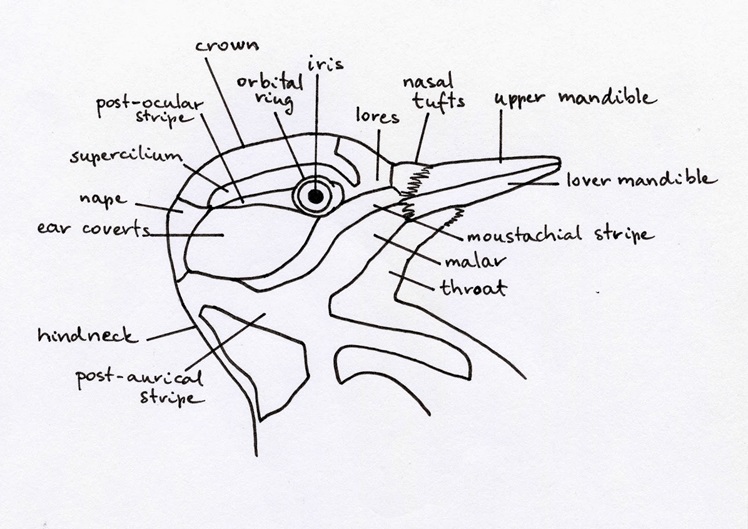Woodpeckers are fascinating birds, known for their unique adaptations that allow them to thrive in their arboreal habitats. These adaptations are manifested in their body parts, each of which serves a specific purpose to aid in their survival. In this article, we will explore the key body parts of a woodpecker and the functions they perform.
A Body Parts Of Woodpecker

1. The Beak
The woodpecker’s beak is one of its most distinguishing features. It is strong, pointed, and chisel-like, perfectly designed for drilling into tree trunks. The primary functions of the beak include:
- Drilling Holes: Woodpeckers use their beak to drill holes in trees to find insects, their primary food source.
- Excavating Nest Cavities: The beak is also used to carve out hollow spaces in tree trunks, which serve as safe nesting sites.
- Communication: Rapid pecking, or drumming, serves as a way to establish territory and attract mates.
The beak is made of keratin and reinforced by a dense bone structure, enabling it to withstand repeated impacts.
2. The Tongue
A woodpecker’s tongue is another extraordinary adaptation. It is long, sticky, and equipped with barbs, allowing the bird to extract insects from deep crevices. Some species even have tongues coated with a sticky saliva for catching prey. The tongue’s length is so impressive that it can extend up to three times the length of the beak. When not in use, the tongue is stored by wrapping around the skull inside the bird’s head.
3. The Skull
The woodpecker’s skull is specially adapted to absorb the impact of pecking. It is thick and spongy, designed to protect the brain from repeated shocks. Key features include:
- Shock Absorption: Spongy bone tissue and a tight fit around the brain cushion it from injury.
- Reinforced Structure: The skull’s unique shape helps distribute the force of each peck evenly.
These adaptations ensure that woodpeckers can peck up to 20 times per second without sustaining brain damage.
4. The Neck Muscles
Strong neck muscles are essential for woodpeckers. They provide the power needed for repeated pecking and help control the direction and force of each strike. The neck muscles also play a role in reducing recoil, ensuring efficient energy transfer during pecking.
5. The Eyes
Woodpeckers have specialized eyes that are well-protected during their pecking activities. Key features of their eyes include:
- Nictitating Membrane: This translucent third eyelid closes to protect the eyes from flying debris and reduces the risk of injury.
- Positioning: The eyes are positioned on the sides of the head, providing a wide field of view to detect predators.
6. The Feet
Woodpeckers have zygodactyl feet, meaning they have two toes pointing forward and two pointing backward. This toe arrangement provides a strong grip on tree trunks and branches. The functions of their feet include:
- Climbing: The zygodactyl structure helps woodpeckers climb vertically with ease.
- Stability: The feet anchor the bird firmly while it drills into wood.
- Manipulation: In some species, the toes can grasp objects, aiding in feeding.
7. The Tail
A woodpecker’s tail is another critical adaptation for climbing and stability. The tail feathers are stiff and pointed, allowing the bird to use them as a prop against tree trunks. Functions of the tail include:
- Support: The tail acts as a third limb, helping the bird balance while pecking.
- Climbing Aid: The stiff feathers provide additional leverage for climbing vertical surfaces.
8. Feathers
While not unique to woodpeckers, their feathers are specially adapted for their lifestyle. The plumage is dense and provides insulation, while also aiding in camouflage. Some species have brightly colored feathers that serve as a warning to rivals or as an attraction to mates.
9. Hearing
Woodpeckers have acute hearing, which is essential for locating insects inside trees. Their ears are covered by feathers that protect them from debris and reduce wind noise, ensuring clear auditory perception. This sharp hearing also helps them detect the sound of insects moving within wood.
10. The Brain
The woodpecker’s brain is small but highly specialized. It’s designed to withstand rapid deceleration forces that occur during pecking. Features include:
- Small Size: A smaller brain reduces the likelihood of damage from impact.
- Positioning: The brain is tightly encased and positioned away from the skull’s point of contact.
11. The Diet and Digestive System
Although not a physical part directly, the woodpecker’s diet influences the functionality of its body parts. Their digestive system is efficient in processing insects, sap, and fruits. The beak, tongue, and even the saliva are all specialized to support their dietary needs.
Conclusion
Each body part of a woodpecker plays a crucial role in its survival. From the sturdy beak to the shock-absorbing skull, every adaptation is a testament to the bird’s ability to thrive in its environment. Understanding these unique features not only highlights the marvels of evolution but also underscores the importance of conserving these incredible birds and their habitats. By protecting woodpeckers, we ensure the preservation of their fascinating adaptations for generations to come.


